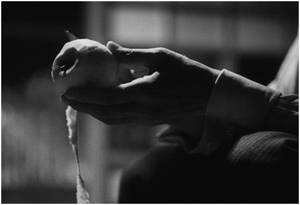March 29th Log
COLOR ME KUBRICK: A TRUE...ISH STORY
2006, Brian Cook, United Kingdom / France
1st Viewing, DVD
Director Brian Cook and writer Anthony Frewin have both worked as assistants for Stanley Kubrick. This film is not at all about Kubrick but about the gay con-artist who impersonated him: Alan Conway. Conway’s story is a fascinating one perhaps mostly because both he and those he fooled seemed to know very little about Kubrick. Perhaps that is the reflection of the film, which observes the obsessive desire of fame and celebrity. It seems only fitting that the lead role of Conway be given to John Malkovich, who’s celebrity status was perfectly exploited in the wonderfully original 1999 film Being John Malkovich. This film shares some of that films themes (the fascination of being someone else or more specifically being someone famous or glamorous). However, Color Me Kubrick is far less original, funny, or even entertaining then Being John Malkovich. That is not to say this is a bad film, because it is not. Malkovich has a whole lot of freedom and fun in the role of Conway, and his performance really makes the entire film.
FLOWING
1956, Mikio Naruse, Japan
Repeat Viewing, DVD
Flowing is simply a perfect film. It is an ensemble film centering on the world of woman living in a geisha house (called Tsuta). The film is a parallel of life daily flow and of the crisis of the geisha house. Flowing cuts between several storylines of each woman of the geisha house. The house is rather small and confined which only heightens the flow of everyday life. Men are hardly seen, but there presence is felt in the financial burden of the geisha house (as well as the reality that the geisha house is survived to serve men (but Flowing is certainly not a film set on sensationalizing geishas in the way many films do). As is a Naruse trademark money and debt obligations becoming a critical factor. From the opening shot, Flowing becomes a film of the flow of life. Within the troubles of the geisha house lies the films emotional core, which is that of the maid, played by the great Kinuyo Tanaka. She is nicknamed Oharu (reminding viewers of her career defining role in Kenji Mizoguchi’s 1952 masterpiece Life of Oharu), and she represents the everyday daily flow of life in the most endearing and caring manner. Oharu is like the outside observer of this world, as Flowing may above all be a film which unites together two different worlds of Japanese women. Each of these women are portrayed with such depth and insight and the powerful ensemble cast of actresses (Isuzu Yamada, Hideko Takamine, Mariko Okada, Haruko Sugimura, Sumiko Kurishima, Chieko Nakakita, Natsuko Kahara) are each outstanding. Of course, Kinuyo Tanaka is standout as the maid, but she is far from alone. There is such complexity in the narrative, the emotions, the performances, and Naruse’s mise-en-scene. However, despite all the complexities and depths at hand, Flowing remains definitive of Naruse in the simplistically formal style. As the title suggest Flowing is a film that flows between characters and between spaces within the geisha house and its environment- as well as the flow the its services and its finances. As the narrative flow moves along, the film intermittently suggest the flow of the passage of time, be it through contemplative moments (the cat, the river, the neighbors in the garden) or through subtle references of passing time (such as the aging process, or advancement of modern technology). Naruse does this all with the most simplistic and masterful stroke, leaving an ambiguous sense not of sadness or inevitability, but of the path, the choices, and the flow of life. The ending is one of the great moments of Japanese cinema. A 7-minute scene of no dialogue that openly leaves the feeling of both the inevitable demise of the geisha house (of even the traditions of the geisha), as well as celebrating the culture and art of the geisha. Naruse flows the sequence by detailing the daughter alone sewing (perhaps preparing a future profession), the maiden teaching the new class of geisha (the future of the house), and the maid fluctuating in-between the two with offerings of a treat (all while being the only one aware of the future). Truly a remarkable and complex moment all done with the touch of simplicity from Naruse, it is a reflection of the entire film and of Naruse as a master. Flowing rates alongside When a Woman Ascends the Stairs as my favorite Naruse film, and it belongs mention among the very greatest ever made.
>> Here is a scene from Flowing:



0 Comments:
Post a Comment
Subscribe to Post Comments [Atom]
<< Home